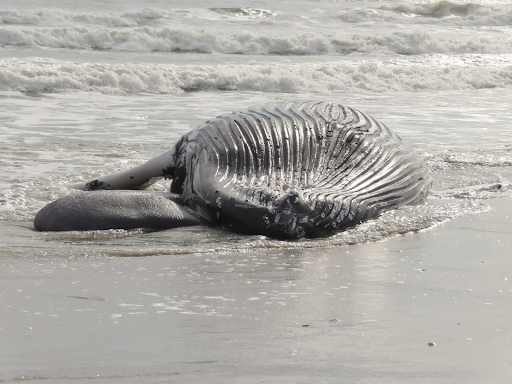Whales wash up dead on Atlantic Coast

Image via Associated Press
A humpback whale was found dead on a beach in New York last Monday, January 30. It is the eighth in a string of whales that have washed up on the shores of New York and New Jersey. The cause of death remains a mystery, though some suspect it to be the recent offshore wind turbine construction activities.
The most recent victim was identified by the Center for Coastal Studies as an over 40 year old whale named Luna. She was found on Lido Beach in New York, with preliminary exams revealing that a vessel strike may be the cause of death, although it could be weeks before an official cause of death is found. Luna was buried on the beach where she was found.
Some environmental organizations have called for a stop of offshore wind turbine pre-construction in the area, believing that the activities of development companies such as seismic work and sonar could be harming the whales in the area.
“Stop all of the sonar, stop all of the pre-construction activity offshore right now, until we can determine whether or not that has had any impact or any part of the cause for all these whales washing up,” said Cindy Zipf, executive director of Clean Ocean Action.
Seismic work can cause loud blasts that can lead to hearing loss and cause communication issues between whales, driving them away from their natural habitats. Sonar noises can similarly disrupt whale behavior, sending them away from breeding and feeding grounds.
However, other environmental organizations have said that the work does not need to stop, and Governor of New Jersey, Phil Murphy has said that offshore work will continue, as there is no evidence linking the pre-construction activity with the whale deaths.
“I just want to be unambiguous,” said Benjamin Laws, deputy chief for National Oceanic and Atmospheric Association (NOAA)’s permits and conservation division. “There is no information that would support any suggestion that any of the equipment that’s being used in support of wind development for [pre-construction survey work] can directly lead to the death of a whale.”
NOAA says that offshore wind developers have systems in place that account for whale migration patterns. In addition, equipment used for wind project testing tends to be quieter and smaller than the equipment used for oil and gas production.
While it is not impossible that the construction of wind turbines could be negatively impacting the whale population in New York and New Jersey, there is another theory. Vessel strikes are one of the most common causes of whale injury and death, since humpback whales tend to come close to the shore in order to forage for food. This means they have to compete with fishermen for the fish in the area. The Marine Mammal Stranding Center has requested that boaters travel less than 10 knots in the waters around New Jersey and to exercise caution while driving.
There has been a concerning rise in whale deaths over the past few years, with a study conducted by NOAA that began in 2016 concluding that vessel strikes, plastic pollution, and fishermen’s nets are the primary causes of fatality. While the agency cannot conclusively say what is causing the death of these specific whales, they expressed their sorrow at the early end to these creatures’ lives.
“NOAA Fisheries is a science agency, and like our collaborators on the marine mammal stranding networks, we do this work because we value marine life and dedicate ourselves to conserving these species,” said Alllison Ferreira, a NOAA spokeswoman. “We join the public and our community in the sadness they feel over the loss of these beautiful animals.
The whales that have died are as follows:
- a 12-foot infant sperm whale in Keansburg, New Jersey on Dec. 5
- a humpback whale in Amagansett, New York, on Dec. 6
- a juvenile humpback whale on Strathmere Beach, New Jersey on Dec. 10
- a female sperm in Rockaway Beach in Queens, New York, on Dec. 12
- a 30-foot female humpback whale in Atlantic City, New Jersey on Dec. 23
- a 30-foot female humpback whale in Atlantic City, New Jersey on Jan. 7
- a 20- to 25- foot long sub-adult humpback whale on Jan. 12 in Brigantine, New Jersey
- a 40-foot adult whale on Jan. 30 near the south coast of Long Island, New York

Emmalina is currently a Senior at South Lakes High School and Co-Editor in Chief of the Sentinel. This is her 3rd year writing for the newspaper, and she...













